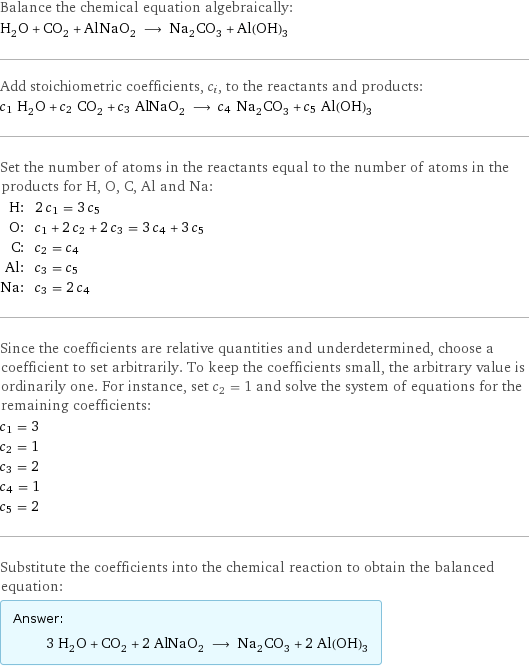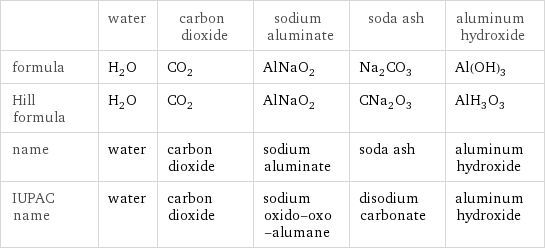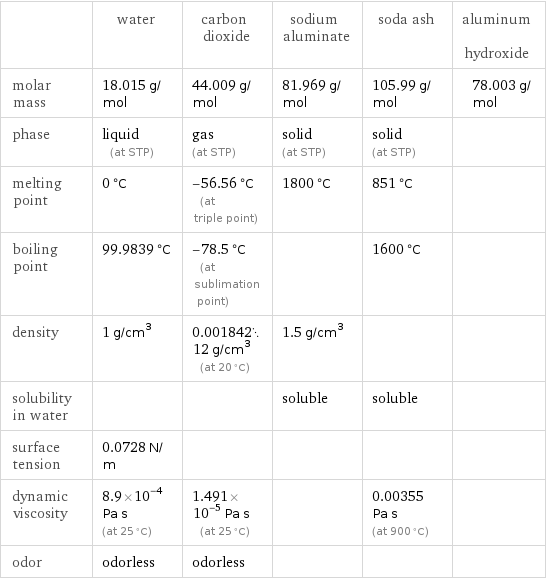Input interpretation

H_2O water + CO_2 carbon dioxide + AlNaO_2 sodium aluminate ⟶ Na_2CO_3 soda ash + Al(OH)_3 aluminum hydroxide
Balanced equation

Balance the chemical equation algebraically: H_2O + CO_2 + AlNaO_2 ⟶ Na_2CO_3 + Al(OH)_3 Add stoichiometric coefficients, c_i, to the reactants and products: c_1 H_2O + c_2 CO_2 + c_3 AlNaO_2 ⟶ c_4 Na_2CO_3 + c_5 Al(OH)_3 Set the number of atoms in the reactants equal to the number of atoms in the products for H, O, C, Al and Na: H: | 2 c_1 = 3 c_5 O: | c_1 + 2 c_2 + 2 c_3 = 3 c_4 + 3 c_5 C: | c_2 = c_4 Al: | c_3 = c_5 Na: | c_3 = 2 c_4 Since the coefficients are relative quantities and underdetermined, choose a coefficient to set arbitrarily. To keep the coefficients small, the arbitrary value is ordinarily one. For instance, set c_2 = 1 and solve the system of equations for the remaining coefficients: c_1 = 3 c_2 = 1 c_3 = 2 c_4 = 1 c_5 = 2 Substitute the coefficients into the chemical reaction to obtain the balanced equation: Answer: | | 3 H_2O + CO_2 + 2 AlNaO_2 ⟶ Na_2CO_3 + 2 Al(OH)_3
Structures

+ + ⟶ +
Names

water + carbon dioxide + sodium aluminate ⟶ soda ash + aluminum hydroxide
Equilibrium constant
![Construct the equilibrium constant, K, expression for: H_2O + CO_2 + AlNaO_2 ⟶ Na_2CO_3 + Al(OH)_3 Plan: • Balance the chemical equation. • Determine the stoichiometric numbers. • Assemble the activity expression for each chemical species. • Use the activity expressions to build the equilibrium constant expression. Write the balanced chemical equation: 3 H_2O + CO_2 + 2 AlNaO_2 ⟶ Na_2CO_3 + 2 Al(OH)_3 Assign stoichiometric numbers, ν_i, using the stoichiometric coefficients, c_i, from the balanced chemical equation in the following manner: ν_i = -c_i for reactants and ν_i = c_i for products: chemical species | c_i | ν_i H_2O | 3 | -3 CO_2 | 1 | -1 AlNaO_2 | 2 | -2 Na_2CO_3 | 1 | 1 Al(OH)_3 | 2 | 2 Assemble the activity expressions accounting for the state of matter and ν_i: chemical species | c_i | ν_i | activity expression H_2O | 3 | -3 | ([H2O])^(-3) CO_2 | 1 | -1 | ([CO2])^(-1) AlNaO_2 | 2 | -2 | ([AlNaO2])^(-2) Na_2CO_3 | 1 | 1 | [Na2CO3] Al(OH)_3 | 2 | 2 | ([Al(OH)3])^2 The equilibrium constant symbol in the concentration basis is: K_c Mulitply the activity expressions to arrive at the K_c expression: Answer: | | K_c = ([H2O])^(-3) ([CO2])^(-1) ([AlNaO2])^(-2) [Na2CO3] ([Al(OH)3])^2 = ([Na2CO3] ([Al(OH)3])^2)/(([H2O])^3 [CO2] ([AlNaO2])^2)](../image_source/bed7825f82feaa08699902d0f4dfd384.png)
Construct the equilibrium constant, K, expression for: H_2O + CO_2 + AlNaO_2 ⟶ Na_2CO_3 + Al(OH)_3 Plan: • Balance the chemical equation. • Determine the stoichiometric numbers. • Assemble the activity expression for each chemical species. • Use the activity expressions to build the equilibrium constant expression. Write the balanced chemical equation: 3 H_2O + CO_2 + 2 AlNaO_2 ⟶ Na_2CO_3 + 2 Al(OH)_3 Assign stoichiometric numbers, ν_i, using the stoichiometric coefficients, c_i, from the balanced chemical equation in the following manner: ν_i = -c_i for reactants and ν_i = c_i for products: chemical species | c_i | ν_i H_2O | 3 | -3 CO_2 | 1 | -1 AlNaO_2 | 2 | -2 Na_2CO_3 | 1 | 1 Al(OH)_3 | 2 | 2 Assemble the activity expressions accounting for the state of matter and ν_i: chemical species | c_i | ν_i | activity expression H_2O | 3 | -3 | ([H2O])^(-3) CO_2 | 1 | -1 | ([CO2])^(-1) AlNaO_2 | 2 | -2 | ([AlNaO2])^(-2) Na_2CO_3 | 1 | 1 | [Na2CO3] Al(OH)_3 | 2 | 2 | ([Al(OH)3])^2 The equilibrium constant symbol in the concentration basis is: K_c Mulitply the activity expressions to arrive at the K_c expression: Answer: | | K_c = ([H2O])^(-3) ([CO2])^(-1) ([AlNaO2])^(-2) [Na2CO3] ([Al(OH)3])^2 = ([Na2CO3] ([Al(OH)3])^2)/(([H2O])^3 [CO2] ([AlNaO2])^2)
Rate of reaction
![Construct the rate of reaction expression for: H_2O + CO_2 + AlNaO_2 ⟶ Na_2CO_3 + Al(OH)_3 Plan: • Balance the chemical equation. • Determine the stoichiometric numbers. • Assemble the rate term for each chemical species. • Write the rate of reaction expression. Write the balanced chemical equation: 3 H_2O + CO_2 + 2 AlNaO_2 ⟶ Na_2CO_3 + 2 Al(OH)_3 Assign stoichiometric numbers, ν_i, using the stoichiometric coefficients, c_i, from the balanced chemical equation in the following manner: ν_i = -c_i for reactants and ν_i = c_i for products: chemical species | c_i | ν_i H_2O | 3 | -3 CO_2 | 1 | -1 AlNaO_2 | 2 | -2 Na_2CO_3 | 1 | 1 Al(OH)_3 | 2 | 2 The rate term for each chemical species, B_i, is 1/ν_i(Δ[B_i])/(Δt) where [B_i] is the amount concentration and t is time: chemical species | c_i | ν_i | rate term H_2O | 3 | -3 | -1/3 (Δ[H2O])/(Δt) CO_2 | 1 | -1 | -(Δ[CO2])/(Δt) AlNaO_2 | 2 | -2 | -1/2 (Δ[AlNaO2])/(Δt) Na_2CO_3 | 1 | 1 | (Δ[Na2CO3])/(Δt) Al(OH)_3 | 2 | 2 | 1/2 (Δ[Al(OH)3])/(Δt) (for infinitesimal rate of change, replace Δ with d) Set the rate terms equal to each other to arrive at the rate expression: Answer: | | rate = -1/3 (Δ[H2O])/(Δt) = -(Δ[CO2])/(Δt) = -1/2 (Δ[AlNaO2])/(Δt) = (Δ[Na2CO3])/(Δt) = 1/2 (Δ[Al(OH)3])/(Δt) (assuming constant volume and no accumulation of intermediates or side products)](../image_source/9c086b65989a0f9f1cbe8bd760611842.png)
Construct the rate of reaction expression for: H_2O + CO_2 + AlNaO_2 ⟶ Na_2CO_3 + Al(OH)_3 Plan: • Balance the chemical equation. • Determine the stoichiometric numbers. • Assemble the rate term for each chemical species. • Write the rate of reaction expression. Write the balanced chemical equation: 3 H_2O + CO_2 + 2 AlNaO_2 ⟶ Na_2CO_3 + 2 Al(OH)_3 Assign stoichiometric numbers, ν_i, using the stoichiometric coefficients, c_i, from the balanced chemical equation in the following manner: ν_i = -c_i for reactants and ν_i = c_i for products: chemical species | c_i | ν_i H_2O | 3 | -3 CO_2 | 1 | -1 AlNaO_2 | 2 | -2 Na_2CO_3 | 1 | 1 Al(OH)_3 | 2 | 2 The rate term for each chemical species, B_i, is 1/ν_i(Δ[B_i])/(Δt) where [B_i] is the amount concentration and t is time: chemical species | c_i | ν_i | rate term H_2O | 3 | -3 | -1/3 (Δ[H2O])/(Δt) CO_2 | 1 | -1 | -(Δ[CO2])/(Δt) AlNaO_2 | 2 | -2 | -1/2 (Δ[AlNaO2])/(Δt) Na_2CO_3 | 1 | 1 | (Δ[Na2CO3])/(Δt) Al(OH)_3 | 2 | 2 | 1/2 (Δ[Al(OH)3])/(Δt) (for infinitesimal rate of change, replace Δ with d) Set the rate terms equal to each other to arrive at the rate expression: Answer: | | rate = -1/3 (Δ[H2O])/(Δt) = -(Δ[CO2])/(Δt) = -1/2 (Δ[AlNaO2])/(Δt) = (Δ[Na2CO3])/(Δt) = 1/2 (Δ[Al(OH)3])/(Δt) (assuming constant volume and no accumulation of intermediates or side products)
Chemical names and formulas

| water | carbon dioxide | sodium aluminate | soda ash | aluminum hydroxide formula | H_2O | CO_2 | AlNaO_2 | Na_2CO_3 | Al(OH)_3 Hill formula | H_2O | CO_2 | AlNaO_2 | CNa_2O_3 | AlH_3O_3 name | water | carbon dioxide | sodium aluminate | soda ash | aluminum hydroxide IUPAC name | water | carbon dioxide | sodium oxido-oxo-alumane | disodium carbonate | aluminum hydroxide
Substance properties

| water | carbon dioxide | sodium aluminate | soda ash | aluminum hydroxide molar mass | 18.015 g/mol | 44.009 g/mol | 81.969 g/mol | 105.99 g/mol | 78.003 g/mol phase | liquid (at STP) | gas (at STP) | solid (at STP) | solid (at STP) | melting point | 0 °C | -56.56 °C (at triple point) | 1800 °C | 851 °C | boiling point | 99.9839 °C | -78.5 °C (at sublimation point) | | 1600 °C | density | 1 g/cm^3 | 0.00184212 g/cm^3 (at 20 °C) | 1.5 g/cm^3 | | solubility in water | | | soluble | soluble | surface tension | 0.0728 N/m | | | | dynamic viscosity | 8.9×10^-4 Pa s (at 25 °C) | 1.491×10^-5 Pa s (at 25 °C) | | 0.00355 Pa s (at 900 °C) | odor | odorless | odorless | | |
Units
